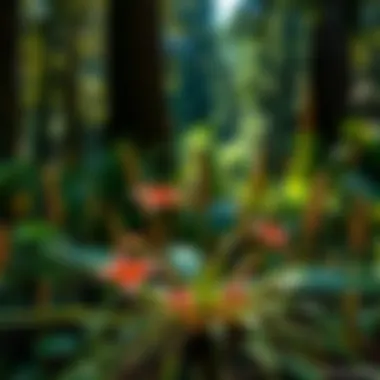Diverse Flora of Redwood National Park Explored


Intro
The sprawling landscapes of Redwood National Park are not just a sight for sore eyes; they represent a dynamic ecosystem where plant life reigns supreme. This introductory section serves as a doorway into the rich tapestry of flora that thrives within the park. It’s not merely about the towering redwoods, known for their impressive height and age; it’s about the intricate relationships that these trees and other plant species cultivate with their environment and the various organisms that call this habitat home.
Within these woods, the delicate dance of life unfolds—a narrative interwoven with the threads of ecological significance, climatic influences, and conservation efforts. From the moss-covered forest floors to the sun-dappled canopies, each corner of this park tells a different story. Understanding these elements is vital, not just for appreciation but for ongoing efforts to preserve this national treasure, which is both a haven for biodiversity and an irreplaceable resource for future generations.
Prelims to Redwood National Park
Redwood National Park, located along the stunning Northern California coast, serves as a testament to nature's grandeur and resilience. This expansive park, which encompasses nearly 139,000 acres, is home to some of the tallest trees on Earth—the coastal redwoods. But these towering giants are just the beginning of what makes this area so remarkable. Beyond the impressive height of the redwoods, the park's diverse ecosystems host a tapestry of flora, each playing a vital role in maintaining ecological balance. This section aims to provide an understanding of the park's significance and the intricate web of life that thrives within its bounds.
Overview of the Park
The landscape of Redwood National Park is as varied as it is breathtaking. From lush temperate rainforests to coastal cliffs, the park presents a mosaic of habitats. One could spend weeks exploring the different trails, each unveiling unique perspectives on the flora and fauna. The majestic redwoods, which can reach up to 379 feet tall and live for over 2,000 years, dominate the skyline. Yet, beneath their grandeur lies an hustling understory filled with ferns, shrubs, and wildflowers, all contributing to the biodiversity that makes this park a UNESCO World Heritage site.
Ecologically, Redwood National Park isn’t just a collection of big trees. It consists of several distinct ecological zones, including coastal ecosystems, riparian zones along riverbanks, and a variety of forest layers, each supporting its own communities of plants.
One might say that the park serves as both a sanctuary and a classroom, offering invaluable lessons in conservation and the fight against environmental degradation. Its various trails and viewpoints allow visitors to appreciate the intricate interplay of life, as well as the ongoing challenges these ecosystems face.
Importance of Biodiversity
Biodiversity within Redwood National Park is not just a collection of species; it reflects the intricate connections that sustain life. Each plant and animal serves a purpose, be it as a pollinator, prey, or even a decomposer. Maintaining high levels of biodiversity ensures the resilience of ecosystems to changes and disturbances.
Among the noteworthy plants are the rare species adapted specifically to the unique conditions of the park. For example, the California bay laurel thrives in the moist, shaded areas beneath the canopy, while coastal wildflowers add splashes of color during the blooming seasons. The interconnection between these species creates a rich tapestry that supports the health of the entire park.
Research shows that regions like Redwood National Park, with their rich biodiversity, can better withstand the impacts of climate change, invasive species, and habitat destruction. They provide essential ecosystem services such as carbon sequestration, soil protection, and water purification.
"Biodiversity is nature’s ultimate insurance policy. By protecting it, we are ensuring a legacy of resilience and sustainability for future generations."
In summary, Redwood National Park is not just an outdoor sanctuary but a living laboratory where every organism contributes to a balanced ecosystem. By understanding the significance of biodiversity within the park, we can better appreciate the need for ongoing conservation efforts and the role each species plays in maintaining the health of our environment.
For more detailed insights, resources from Wikipedia and Britannica may provide additional context.
Ecological Zones Within the Park
The ecological zones of Redwood National Park present a tapestry of diverse habitats, each playing a crucial role in fostering the park's rich biodiversity. Understanding these zones not only highlights the intricate relationships among plant and animal species but also sheds light on how environmental factors influence their dynamics. From the rugged coastline to the towering forest canopies, each zone contributes unique resources and conditions essential for the survival of various species. This section will explore three primary ecological zones: the coastal ecosystems, the riparian zones, and the distinct forest layers, leading to a better comprehension of their interconnections and ecological significance.
Coastal Ecosystems
The coastal ecosystems of Redwood National Park are a treasure trove of biodiversity, where land meets the ocean in a dynamic interplay. This area is characterized by coastal marshes, bluffs, and sandy beaches, providing vital habitat for numerous plant and animal species.
- The coastal vegetation is predominantly composed of hardy plants adapted to salty spray and sandy soils. These include beach strawberry (Fragaria chiloensis) and sea rocket (Cakile spp.), both of which thrive in this exposed environment.
- Additionally, the nutrient-rich waters off the coast feed a rich array of marine life, providing support for seabirds and coastal wildlife. The tidal pools along the shore are brimming with life, hosting unique species like anemones, sea stars, and crabs.
Furthermore, coastal ecosystems are vital for maintaining ecosystem health due to their protective role against erosion and storm damage. By buffering the impacts of waves and storms, they safeguard the inland habitats, making them indispensable to the overall ecological balance.
Riparian Zones
The riparian zones that line the rivers and streams within Redwood National Park serve as critical interfaces between aquatic and terrestrial ecosystems. These areas are marked by lush vegetation that thrives off the nutrient-rich sediments deposited by flowing waters.
- Dominated by species like willows and alder, these zones harbor a diverse understory of shrubs and herbaceous plants that provide both food and shelter for an array of wildlife.
- The cool, shaded conditions foster by the canopies create an ideal habitat for species such as the elusive Pacific giant salamander and various nesting birds.
Riparian zones also play an essential role in water quality. They filter pollutants, enhance biodiversity, and regulate water temperature, contributing to the health of aquatic ecosystems. Thus, preserving these zones is paramount not just for the species that inhabit them but for the overall vitality of the park's environment.
Forest Layers
The towering redwoods form the backbone of the forest layers in Redwood National Park, but it’s the layering of different flora that creates the remarkably rich biodiversity found here. Within these layers, distinct ecological niches support a variety of plants.
- The upper canopy, dominated by the majestic sequoia sempervirens, can reach heights of over 350 feet, creating a microclimate below that is cooler and more humid. Here, mosses and ferns hang from branches, forming a lush tapestry.
- The understory, often cloaked in shadows, showcases a variety of shrubs and flowering plants such as the salal and trillium, which thrive in low light. This layer is critical for many bird species and insects, relying on the resources it provides.
- Finally, the forest floor, a dark and damp canvas, is alive with decomposing leaf litter and root systems, serving as a nutrient reservoir for the entire ecosystem.
Each layer's unique characteristics and plant diversity support interdependent relationships, demonstrating the importance of vertical stratification in promoting resilience against environmental changes.
"The intricate design of forest layers exemplifies nature’s ingenuity, showcasing a system where each part, no matter how small, plays a vital role in the health of the entire ecosystem."


These ecological zones illuminate the diverse plant life and their interdependencies, which form the backbone of Redwood National Park's integrity. Preserving these areas not only protects unique species but also ensures the overall health of these vital ecosystems, making it necessary for current and future conservation efforts.
Plant Diversity in Redwood National Park
The plant diversity within Redwood National Park is not only a treasure trove of biological wealth but also a critical element in maintaining the ecological balance of the region. This diverse assembly of flora plays a vital role in supporting wildlife, regulating climate, and providing various ecosystem services. To appreciate fully the significance of plant diversity here, one must delve into the rich tapestry of species, their interrelations, and the unique conditions that foster such biodiversity.
Redwood Trees: The Giants
At the heart of Redwood National Park is the iconic redwood (Sequoiadendron giganteum), towering majestically above all other trees. These giants can reach heights of over 300 feet, making them some of the tallest living organisms on earth. Their towering presence not only inspires awe but also offers numerous ecological advantages.
Understanding redwoods goes beyond their size; these trees have adapted to thrive in specific microclimates. Their thick, fibrous bark is resistant to fire and pests, allowing them to live for hundreds, sometimes thousands, of years. The high canopy they create forms a unique habitat that supports a plethora of associated species, including ferns, mosses, and lichens, each contributing to the park's overall biodiversity. Without the redwoods, the ecological framework of the park would collapse, showcasing how a single species can influence an entire ecosystem.
Understory Flora
The understory of Redwood National Park is a vibrant niche teeming with life. Below the towering trees lies a rich layer of plants that serve essential roles in this ecosystem. From the delicate trillium to the robust salal (Gaultheria shallon), these plants have evolved to thrive with limited sunlight.
This shaded environment promotes unique growth patterns and adaptations. For instance, many understory species have wide, broad leaves to capture maximum light. Others develop symbiotic relationships with fungi, enhancing nutrient uptake from the forest floor.
Among these floor-dwelling species, one can find various ferns, flowering plants, and shrubs, each adding layers to the complex interactions occurring beneath the redwood canopy. The understory not only provides food and shelter for countless insects and animals but also helps in soil stabilization, water retention, and nutrient cycling—the unsung heroes of the ecosystem.
Rare and Endemic Species
In Redwood National Park, the concept of rarity takes an interesting turn. Some species that call this park home are not found anywhere else on earth, making their conservation crucial. One notable example is the Humboldt lily (Lilium humboldtii), a striking flower that captivates with its vibrant hue and delicate structure.
The park’s unique geology and climate have fostered conditions where specific plants can thrive in isolation. These rare and endemic species add to the biological importance of the park, as they contribute to genetic diversity, which underpins ecosystem resilience. Protection of these species ensures that we maintain the richness of the park's flora. Conservation initiatives are not merely about preserving scenic beauty; they are imperative for the continuity of ecological relationships that have persisted over millennia.
In summary, the plant diversity within Redwood National Park is a complex interplay of towering giants, intricate understories, and rare entities that together create a vibrant, living ecosystem. Such diversity is essential, fostering resilience and adaptability in the face of environmental changes. Understanding it is crucial not only for biodiversity but also for the sustainability of our natural resources.
Adaptations of Plant Species
Adaptations of plant species within Redwood National Park represent a critical area of study, shedding light on how flora responds to specific environmental pressures. This section delves into the remarkable adaptations that allow these plants to survive and thrive in their unique habitats. By examining survival strategies and responses to microclimates, it becomes clear how intricate the relationships between plants and their ecosystems can be.
Survival Strategies
Plants in Redwood National Park have developed a range of survival strategies that enable them to endure diverse climatic conditions and soil types. Some of these include:
- Thick Bark: The coast redwood, known scientifically as Sequoiadendron giganteum, has evolved thick, fibrous bark that acts as a protective barrier against fire and pests. This tough exterior allows the trees to withstand wildfires, a natural occurrence in their environments.
- Deep Root Systems: Many of the park's plant species, including various ferns and shrubs, often develop expansive root systems. These roots help anchor them firmly in the soil while accessing moisture deep within the ground, which is particularly important during dry spells.
- Water Storage: Plants like the Pacific rhododendron (Rhododendron macrophyllum) can store water in their thick, leathery leaves. This adaptation helps them survive prolonged dry periods, showcasing their ability to utilize scarce resources effectively.
- Shade Tolerance: The dense canopy created by towering redwoods creates a shaded environment where light is limited. Understory flora, such as huckleberries and salal, have adapted to these low-light conditions by developing broader leaves that can capture more sunlight.
"Adaptation isn’t just a survival tactic; it’s a blueprint for success in a challenging world."
These strategies illustrate the complexity of ecosystem dynamics in Redwood National Park, showing how diverse plant species compete and coexist within their senstive habitats.
Responses to Microclimates
Microclimates within Redwood National Park are varied, driven by factors like elevation, proximity to the coast, and forest density. As such, plant species here exhibit fascinating responses that enhance their adaptability.
- Variation in Vegetation Types: The park has zones where different plants thrive under distinct climatic conditions. Higher elevations often host species such as the white fir (Abies concolor), which require cooler climates, while lower areas may support chaparral plants that favor warmth.
- Humidity Regulation: Certain plants have adapted to manage humidity levels in their environment. For instance, Sphagnum mosses can retain moisture, creating a damp environment conducive for other nearby species, which in turn affects local microclimates.
- Climate Resilience: As climate patterns shift, some plant species exhibit resilience through seasonal bloom adjustments. For example, the California poppy (Eschscholzia californica) has been observed to alter the timing of its flowering in response to temperature changes, ensuring reproduction occurs during optimal conditions.
In summary, the adaptations of plant species in Redwood National Park are not merely a response to environmental challenges but a complex interplay of survival tactics and innovative adjustments. These adaptations not only allow individual species to thrive but also play a pivotal role in maintaining the ecological balance of the park's ecosystems.
For further reading:
Understanding these adaptive mechanisms is crucial for conservation efforts and future research aimed at preserving the unique biodiversity found within Redwood National Park.
Interactions with Fauna
Understanding the interactions between flora and fauna is vital in appreciating the complex ecosystem of Redwood National Park. These relationships do not just exist in a vacuum; they form a web of dependencies that influence both plant and animal life. The intricate dance between different species illustrates the interdependence necessary for maintaining biodiversity. This section will explore two main types of interactions: pollination relationships and seed dispersal mechanisms, unraveling how plants and animals collaborate to thrive in this unique environment.
Pollination Relationships
Pollination is a fundamental process that enables the reproductive success of many plant species in Redwood National Park. Various flora, including the iconic coast redwood, complexly engages with local fauna, particularly insects, birds, and mammals that assist in the transfer of pollen.


- Mutual Benefits: In this relationship, plants provide nectar or pollen as a reward for the services insects and animals offer. For example, native bees, like the Western bumblebee, are significant pollinators for redwood sorrel and other flowering species. The bees are lured by the sweet nectar, while inadvertently transferring pollen from one flower to another, enhancing genetic diversity and resilience.
- Specialized Interactions: Some plant species have evolved specialized traits to attract specific pollinators. The vibrant blooms of the California poppy, for instance, open wide in the daylight to attract a range of bee species. At the same time, some plants, such as the redwood tree itself, rely on wind for pollination but still benefit from interactions with local creatures, which can inadvertently transfer pollen during their activities.
Understanding these relationships is critical for conservation efforts. Disruptions to the fauna involved in pollination, whether from habitat loss or climate shifts, can jeopardize the reproductive success of numerous plant species. Therefore, safeguarding the habitats of pollinators is as vital as preserving the plants themselves.
Seed Dispersal Mechanisms
Seed dispersal is another essential interaction between flora and fauna that affects the dynamics of plant populations. Many plant species have developed ingenious strategies to ensure their seeds reach suitable locations for germination and growth.
- Animal-assisted Dispersal: Some seeds have evolved to attach to animal fur or to be ingested and later excreted, thus utilizing animals as agents of dispersal. The seeds of the sticky monkeyflower, for example, develop small barbs that adhere to the fur of animals, allowing them to travel far distances.
- Wind and Water: Other species rely on physical elements for seed dispersal. Seeds like those of the dandelion can be carried away by the wind, allowing them to settle in diverse areas. Additionally, some seeds float and can be transported by water, which is particularly relevant in riparian zones where streams and rivers traverse the park.
- Plants and Their Seed Adaptations: Specific plants have adapted their seeds to withstand the digestive process of animals, which can enhance germination. The seeds of the acorn are an example; squirrels bury them as a food source, but many are left to grow into oak trees, contributing to the park’s forest structure.
These interactions highlight the profound interconnectedness of plants and animals in Redwood National Park. Preservation of both flora and fauna is vital for sustaining the health of this intricate ecosystem.
The awareness of these relationships shapes conservation strategies, illustrating that the survival of one group often directly affects the other. Maintaining a balanced ecosystem, thus, requires a holistic approach, considering how these relationships operate in the broader context of biodiversity.
Soil Composition and Its Effects
Soil composition plays a pivotal role in shaping the flora of Redwood National Park, affecting not just plant health but the overarching ecosystem. Healthy soil is the foundation for thriving plant life, influencing everything from nutrient uptake to moisture retention. In an environment like Redwood National Park, where towering trees and diverse plant species grow side by side, understanding soil composition is crucial for conserving these unique habitats.
Nutrient Availability
The availability of nutrients in soil largely determines which plant species can thrive in a given area. Redwood National Park's soil is primarily composed of loamy and clay-rich materials, providing an ideal mix that holds moisture while allowing roots to breathe. Nutrient-rich soils often stem from the decomposition of organic matter, primarily fallen leaves and decaying wood. Here, nitrogen, phosphorus, and potassium are key players in promoting plant growth. With the cyclic nature of decomposition, these nutrients get recycled into the soil, ultimately benefiting the vast range of flora.
- Organic matter contributes to both soil fertility and structure, enhancing roots' access to essential nutrients.
In addition, the park’s unique geological history influences nutrient availability. Volcanic activity long ago enriched the soils with minerals that benefit the thriving coastal redwoods. As a result, the park is home to seedlings growing in nutrient-rich areas and species like huckleberries or ferns that prefer more acid soils.
Influence of Microbial Communities
Microbial communities within the soil ecosystem are the unsung heroes of nutrient cycling and soil health. In Redwood National Park, these communities comprise bacteria, fungi, and actinomycetes, each contributing to the maintenance of soil structure and fertility. These microorganisms break down organic matter, releasing nutrients back into the soil and making them available for plant absorption.
The relationship between plants and soil microbes is often symbiotic. For example, mycorrhizal fungi form partnerships with plant roots, enhancing nutrient uptake, particularly phosphorus. Similarly, nitrogen-fixing bacteria can transform atmospheric nitrogen into forms usable by plants, enriching the soil.
Furthermore, disturbances to these microbial communities—whether through human activity or natural events—can have cascading effects on nutrient cycles and, by extension, plant health. Conserving intact habitats helps maintain the delicate balance of these soil microbes, ensuring the flora of Redwood National Park can continue to flourish and support biodiversity.
Resources for further exploration include United States Geological Survey, National Park Service and various academic articles on soil health found on Google Scholar.
Understanding soil composition and its multifaceted effects gives a clearer picture of the rich tapestry of life that exists within Redwood National Park. This intricate web, woven from soil to canopy, underlines the importance of continued research and conservation efforts.
Climate Influence on Flora
Climate plays a pivotal role in shaping the flora of Redwood National Park. The unique microclimates within the park create a tapestry of habitats where diverse plant species can thrive. From the coastal fog that blankets the forest floors to the intricate interplay of sunshine and shade, the climatic conditions influence plant distribution, growth, and overall ecosystem health. In this section, we will explore how microclimate variability and the looming specter of climate change affect these remarkable plant communities.
Microclimate Variability
Microclimates within Redwood National Park exhibit remarkable diversity. These variations stem from factors such as elevation, proximity to bodies of water, and the orientation of slopes. For example, the coastal regions experience heavy fog, providing a moist environment crucial for the survival of certain plants. This moisture allows species like the western sword fern to flourish, adapting to the shaded understory beneath towering redwoods.
On the other hand, areas slightly away from the coast might bask in direct sunlight, making them suitable for sun-loving plants such as California poppy and various grasses. The interplay between sun and shade also creates niches where rare flora, such as the redwood sorrel, can find suitable living conditions. Understanding these microclimates not only enriches our knowledge of plant diversity but also highlights their intricate relationships with habitat conditions.
"The resilience of plant life in the face of microclimate variability showcases nature's brilliant adaptability and the importance of diverse ecosystems."
Impact of Climate Change
Climate change poses a significant threat to the flora of Redwood National Park. As global temperatures rise, or patterns of precipitation shift, the delicate balance maintained for centuries could be disrupted. The increased frequency and intensity of droughts in California could stress water-loving species, potentially leading to declines in plant populations.
Additionally, as the climate continues to change, species migration may occur, with some plant types moving northward or to higher elevations in search of more favorable conditions. This shift can lead to competition and potential loss of unique species that have adapted specifically to the local environment. The interaction between existing flora and newly arriving species can transform the plant communities' structure, altering the fundamental dynamics of the ecosystem.
In response to these changes, ongoing research and monitoring efforts are vital to understand the full range of impacts climate change has on Redwood's plant life. It helps inform conservation strategies that adapt to these evolving challenges, ensuring the protection of these magnificent ecosystems for future generations.
Conservation and Restoration Efforts


Conservation and restoration efforts play a crucial role in maintaining the delicate balance of ecosystems within Redwood National Park. The significance of these initiatives extends beyond preserving individual plant species; they encompass broader ecological health, wildlife habitats, and community engagement. This section delves into specific conservation actions, underlying benefits, and the imperative considerations that guide these efforts.
Current Conservation Initiatives
Several programs and projects are underway in Redwood National Park that aim to protect its flora and restore degraded environments. These initiatives often involve collaborations between park officials, research institutions, and local organizations. They focus on a range of activities, including:
- Invasive Species Management: This initiative addresses the threat posed by non-native plants that compete with native flora for resources. Efforts to tackle invasive species such as Scotch broom have shown positive results in restoring natural habitats.
- Habitat Restoration Projects: Specific areas within the park have undergone rehabilitation, where native plants are reintroduced to revive ecosystem functionality. For instance, riparian restoration projects aim to restore streamside vegetation, enhancing habitat for aquatic species.
- Wildfire Management: Considering the increasing frequency of wildfires, strategies have been put in place to minimize their impact on both flora and fauna. Controlled burns and firebreaks are tools used to prevent larger, uncontrolled wildfires.
- Biodiversity Monitoring: Ongoing research helps track changes in plant communities, guiding future conservation strategies. This monitoring ensures that the park adapts its approaches based on data-driven insights.
"Conservation is a state of harmony between men and land." – Aldo Leopold
Community Involvement in Stewardship
One of the valuable aspects of conservation in Redwood National Park is the active involvement of the community. Engaging local communities not only fosters stewardship but also enhances the effectiveness of conservation efforts. Programs that encourage public participation include:
- Volunteer Programs: Opportunities for community members to participate in clean-up events, tree planting activities, and educational workshops help cultivate a sense of ownership over the land.
- Educational Outreach: Schools and local organizations often collaborate with park management to provide programs that teach students about biodiversity, conservation techniques, and the importance of native flora.
- Citizen Science Projects: Involving residents in biodiversity monitoring contributes invaluable data while fostering a deeper connection to their natural surroundings. Volunteer data collectors assist in tracking the health of ecosystems, which enhances the park's management practices.
In sum, conservation and restoration efforts in Redwood National Park are multi-faceted and dynamic. With solid initiatives backed by active community participation, the park serves as a model for effective stewardship, illustrating how collaborative efforts can lead to a thriving ecosystem.
Research and Monitoring
Research and monitoring sit at the crossroads of conservation and understanding in any ecosystem, but in the context of Redwood National Park, their significance takes on a whole new level. Given the unique biodiversity and ecological complexity of this national treasure, research initiatives not only enhance our knowledge but also underpin the strategies for effective stewardship and conservation efforts. The delicate balance of life within these towering forests demands a rigorous approach to scientific inquiry. While it may seem straightforward, the nuances behind these efforts reveal their absolute necessity for sustaining the park's flora and fauna.
Among the myriad benefits of research, enhancing our comprehension of plant species interactions plays a central role. Armed with data from careful studies, scientists can assess how specific flora contribute to overall ecosystem health and resilience. Moreover, monitoring allows for the identification of potential threats—be it climate variability or invasive species—that might jeopardize this fragile environment.
Long-Term Ecological Studies
Long-term ecological studies are the backbone of understanding the dynamic ecosystems present in Redwood National Park. Researchers typically focus on specific plant populations and their interactions over extended periods to garner insights that short-term observations might miss. For instance, studying how redwood saplings respond to variations in temperature and moisture over years helps in predicting their survival prospects as climate patterns shift.
These studies often yield data regarding:
- Species resilience: Long-term observation reveals how certain species withstand changing conditions compared to others.
- Habitat alterations: Changes in habitat due to natural occurrences can be documented, helping to predict future variances.
- Dietary shifts of herbivores: Monitoring the flora may illuminate shifting preferences in herbivore diets based on available resources, affecting the entire food web.
Collaboration among institutions enhances these studies. Researchers frequently partner with universities and government agencies to share findings, enabling a richer understanding of the relationships present in the ecosystem.
The Role of Technology in Research
Technology plays an indispensable role in modern ecological research, significantly shaping our understanding of the flora within Redwood National Park. Advanced tools and techniques leap beyond traditional methods, allowing researchers to collect data with remarkably increased precision.
Some examples of how technology is utilized include:
- Remote sensing: Satellite and drone imagery can analyze vegetation patterns over large areas, identifying changes that might otherwise go unnoticed.
- Genetic analysis: Genetic sequencing provides insights into species diversity and the genetic health of populations, which is vital for effective conservation strategies.
- Data analytics: Software can process mountains of data from long-term and new studies, helping researchers draw correlations and forecast future ecological trends.
Incorporating technology not only streamlines the research process but also amplifies the reach of findings. Enhanced data sharing platforms allow for broad collaboration and discussion among professionals, facilitating a community-driven approach to addressing environmental challenges.
In essence, the synergy between thorough research, long-term studies, and advanced technology is essential for preserving the intricate web of life that characterizes Redwood National Park.
As we forge ahead, prioritizing these methods will ensure that the park's rich flora—and the ecosystems they support—continue to thrive against the backdrop of inevitable environmental change. To learn more about ecological data collection and analysis, visit the USGS or delve into studies found on ResearchGate.
Engaging with ongoing research initiatives sets a foundation not only for the conservation of Redwood National Park's unique flora but also inspires the next generation of environmental stewards.
Ending
In examining flora within Redwood National Park, it's clear this environment is more than just home to towering trees; it encompasses a complex web of life that demonstrates the significance of biodiversity. The conclusion of this exploration underscores several crucial aspects.
Summary of Key Insights
The primary takeaway from this article is that the flora of Redwood National Park is intricately tied to its ecological health and resilience. Key insights include:
- Rich Biodiversity: The park supports a variety of plant species, from the majestic redwoods to the lesser-known understory plants. This diversity plays a critical role in maintaining the ecological balance.
- Adaptation Mechanisms: Numerous species exhibit unique adaptations that enable survival in diverse conditions, showcasing nature's ingenuity.
- Interconnected Ecosystems: The interdependence of plant and animal life highlights the importance of protecting all species within these ecosystems, as each organism plays a role in sustaining the environment.
- Impact of Climate: Changes in climate have profound effects on plant life, altering habitats and influencing interactions between species. Monitoring these changes is vital for conservation efforts.
By collating these insights, one can appreciate the multifaceted role that plant life plays not only in the park's ecology but also in providing ecological services that benefit broader landscapes and communities.
Future Directions for Research
Looking ahead, the path of research in Redwood National Park holds much promise. Future studies might delve into several promising areas, including:
- Long-term Ecological Monitoring: Understanding trends over time regarding plant health and species distribution can aid in recognizing how climate and policy changes affect this vibrant ecosystem.
- Climate Adaptation Strategies: Exploring plant resilience against climate change will be critical. Identifying which species are most vulnerable can guide restoration efforts and assistance initiatives.
- Technology Integration: Utilizing advanced technologies such as drone monitoring and remote sensing can enhance data collection, revealing previously unnoticed patterns in plant distributions and health.
- Community Engagement in Research: By involving local communities in citizen science projects, valuable insights can be gathered through participatory observation, enriching research outcomes and fostering stronger stewardship connections.
"Understanding these elements isn’t just academic; it's about shaping our approach to conservation and ensuring the vitality of Redwood National Park and similar ecosystems across the globe."















